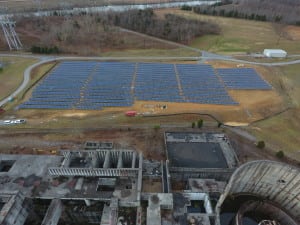Abandoned TVA Nuclear Site Has New Life as Solar Farm
A long-shuttered Tennessee nuclear power plant project has been reborn as a solar farm, with the energy produced there made available for use by local residents and the Tennessee Valley Authority (TVA).
The Phipps Bend Nuclear Power Plant project in Surgoinsville was canceled by TVA in 1981, a victim of the negative sentiment toward nuclear power after the Three Mile Island incident in Pennsylvania in 1979, along with economic problems in the region that had lessened power demand. The project was more than 40% complete; TVA annual reports and other documents show the agency had invested as much as $1.5 billion in the project before it was abandoned.
An industrial park was later built in the area but the site remained mostly untouched until Charlotte, N.C.-based Birdseye Renewable Energy partnered with United Renewable Energy of Alpharetta, Ga., earlier this year to design and build the solar farm, which recently began providing power to surrounding Hawkins County and to the TVA grid. Completion of the solar farm was celebrated July 4 in a ceremony at the site.

Solar and wind power continue to grow as a percentage of the U.S. power portfolio, and now make up more than 10% of the nation’s total power generation, according to the Energy Information Administration (EIA). President Donald Trump’s administration earlier this year said the U.S. Department of Energy (DOE) would invest as much as $30 million into new projects to support integration of solar power into the U.S. electric grid.
Birdseye already had operations in the area around Surgoinsville, with solar panel installations helping power several schools in the region. The $1.8 million Phipps Bend project includes more than 3,000 solar panels across about six acres. Birdseye is selling the power to Holston Electric Cooperative, which serves Hawkins and Hamblen counties in East Tennessee. Holston is a customer-owned distributor of TVA power.
The solar farm is part of TVA’s Solar Solutions Initiative (SSI). The initiative provides incentive payments for mid-size solar projects in TVA’s region through its Renewable Standard Offer program, which requires projects to use local certified solar installers.
Birdseye officials said the plant has 1 MW of peak production, with output of 1,100 to 1,400 MWh/year. Birdseye expects the plant will run for at least 30 years. A 2016 report from solar panel manufacturer SolarCity said today’s solar panels should still produce about 80% of their power after 35 years in service. The Phipps Bend panels utilize a tracking system that adjusts the angle of the panels to receive maximum sunlight throughout the day.
Birdseye owner Brian Bednar told those at Tuesday’s ceremony that “We identified this site, which is essentially the ideal size for a one-megawatt program that fits the SSI program. And it was a piece of the industrial park that really didn’t have as good applicability for large employers or large manufacturers.”
Repurposing brownfield sites as solar projects is happening worldwide. Several companies, including some from the U.S. and Canada, have discussed development of a solar plant at the Chernobyl nuclear site in the Ukraine. Other projects include the placement of solar arrays and wind farms on top of abandoned strip mines. The U.S. Environmental Protection Agency (EPA), in conjunction with the Dept. of Energy’s National Renewable Energy Lab in Golden, Colo., has looked at more than 80,000 brownfield sites to study their potential for renewable energy.
One of the earliest brownfield sites to be repurposed as a solar farm was an EPA Superfund site in Indianapolis, Ind. The Maywood solar farm was built on the site of a former tar and chemical plant.
–Darrell Proctor is a POWER associate editor (@DarrellProctor1, @POWERmagazine)